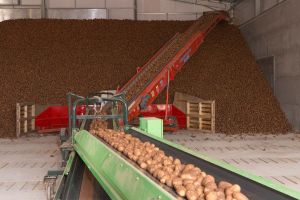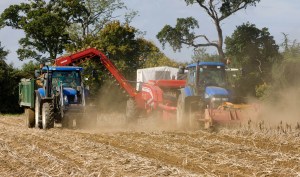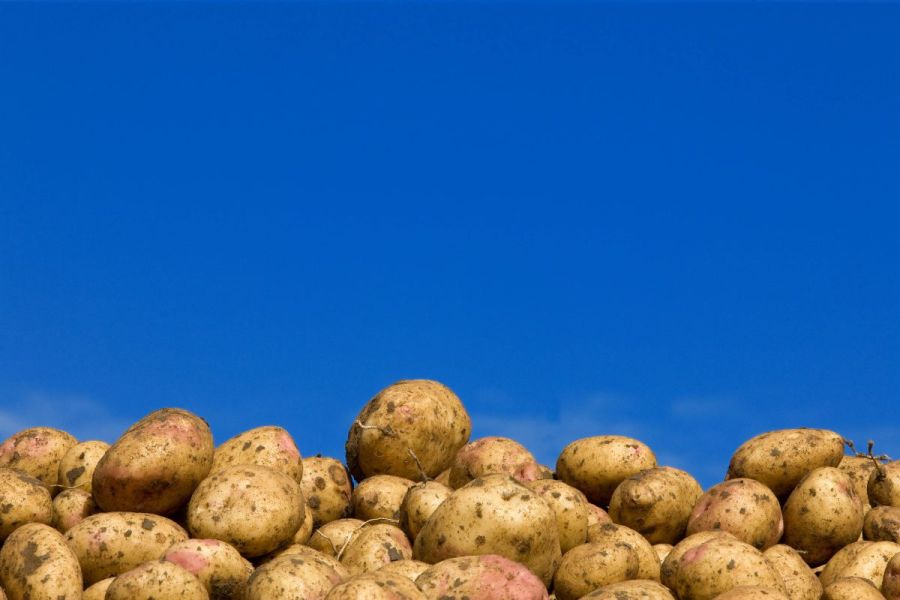There’s little doubt that 2022 has been a memorable season and particularly challenging for those growing potatoes. CPM takes a look at how this season is stacking up.
“Those seeking to feed the nation with potatoes and vegetables have suffered terribly and this will be reflected rapidly both in terms of scarcity, quality and price.”
By Lucy de la Pasture
There’s an old adage that life can only be understood by looking backwards but must be lived forwards. It’s possible that the same could apply to growing potatoes.
Agrovista agronomist Neil Buchanan admits to remembering 1976. As just a teenager, he recalls it seemed rather fun. “I was oblivious to any consequences for British farmers and the lurking menace of global warming and climate change, we just enjoyed it until the rains came in the middle of September.”

Yields have been hit by the drought this season, with low yields being reported some stores may not be filled to capacity – making store management more tricky.
Fast forward to the summer of 2022 and he has a different perspective. “The damage and trauma wrought by Mother Nature this summer will stay fresh in our memories for generations. Stifling temperatures, coupled with widespread drought, ravaged many sectors of our industry. Crops withered, driven to early senescence, yields and quality evaporated and landscapes were covered by the black scars of fire.
“While growers with combinable crops didn’t fare too badly in the West, with yields in many cases above expectation, those seeking to feed the nation with potatoes and vegetables have suffered terribly and this will be reflected rapidly both in terms of scarcity, quality and price.”
Despite all the recent government pledges on food security and sustainability, it quickly became apparent that the Environment Agency was treading a different path, says Neil. “Their continued intransigence to help farmers, despite their numerous pleas, has highlighted how far down its list of priorities farming and food production actually are.”
He points out that potatoes will be in short supply this season and, as one of the staples of the UK diet, there’s demand for them throughout the year. “Whether as fresh or processed, the market demands supplies from growers for every month of the year – new crop, later maincrop or potatoes for processing as chips, fries, crisps and other snacks or ready meals.
“The only way to ensure that we are able to meet this demand with British potatoes is by sustainable, long-term storage. Failure in this respect can only be offset by a dramatic rise in imports.”
Potato acreage in the UK, despite some reductions, has tended to gravitate towards the larger growers. “This is hardly surprising when you consider the massive investment involved, not just to grow the crop, but to build and run these complex stores – notwithstanding the massive hikes in their energy costs. The challenge of lifting potatoes in mid-September and then supplying them back to the market in good condition, some 10 months later, needs both skill and nerve for those who take it on.”
Neil highlights that successful long-term storage needs good early planning, starting at planting time and not when harvesting starts. “Fields have to be matched to variety, soil type, planting date and maturity. Failure to be proactive in these areas will just increase the risk of poor results,” he notes.
Conditions at lifting are obviously crucial, with growers looking for clean, set-skinned, undamaged product going into store. “This isn’t always easy as we move into autumn, but if they don’t go in right, they won’t come out right.”
Looking at the current crop, Neil says the ravages of the summer weather are easy to spot, even in irrigated crops. “We find ourselves in the situation where irrigated ground is in short supply and, as such, the proportion of unirrigated crops has increased. This may relate to growers searching for clean PCN-free fields but is also down to the trend of newer varieties deemed suitable for this scenario.”

In recent years there’s been a shift towards growing potatoes on unirrigated land and where water was available this season, it was often in short supply.
Whatever the reasons, 2022 will be remembered for the wrong reasons, he says. “The trade is awash with stories of fieldsmen reporting poor results from test digs. Not only will it be difficult to fill stores this season, it will be equally difficult to manage them to ensure a good outturn.”
Why? Neil says it’s easy to see when you break down what’s trying to be achieved in store, a list which includes sprout suppression, reduction or elimination of weight loss, prolonging dormancy, maintenance of fry colours, reducing respiration and ensuring a marketable appearance when being graded out.
“Most of these fall into the category of store management, but it really starts before that – in the field. Maleic hydrazide applied to the crop is the keystone to getting a storage programme off to a good start. Getting the timing accurate remains a frustrating challenge and matching agronomic considerations with climatic conditions has proved exceptionally difficult this season, and there are many instances where difficulties proved insurmountable and the product remains in the shed.”
UPL, marketeers of Fazor, acknowledge the problems caused by the weather this year. “Trying to get the timing right to fulfil the major label criteria, such as haulm showing active growth, higher relative humidity, crops not under stress, 3-5 weeks before desiccation, apply on its own etcetera, hasn’t proved easy, with the exception of the label comment which suggests ‘application within 24hrs of rainfall is advised against’.”
Despite this, UPL remain positive about a positive outcome for those who did manage to apply MH, says Neil. “It’s important not to forget the other benefits of reducing secondary growth and chain tuberization, both of which may be an issue this year. Its other prime role of reducing groundkeepers will likely be key with the predominance of small tubers in the ridge this season.”
But on the otherhand, he points out that the weather this season means there has to be an assumption that uptake by the plant was reduced because of the high temperatures and moisture stress. If this is the case, then so too will its persistence and efficacy in store.
“We’re unable to say at this point, and it will only become apparent by being vigilant once the store is loaded. This will be critical in determining the choice of product and its timing for that first treatment once tubers are in the store. It’s sure to be earlier than normal,” he notes.

Dry conditions at harvest add to the woes of potato growers, with the high dry matter potatoes this year even more susceptible to bruising and damage than usual.
Perhaps another complication to contend with this year, concerns the above average dry matter levels being reported. “Failure to address this issue at harvest will mean higher levels of damage and consequently greater ingress of secondary pathogens. However, there are some positives from this season. Desiccation is likely to be easier, quicker and more effective. Skin set is likely to be more rapid with better conditions for curing and healing.”
For those with irrigation capacity remaining, an application prior to lifting will allow some cushioning of tubers from soil on their journey up the web, adds Neil.
“Tuber blight is unlikely to be an issue for this year but there are plenty of other fungal and soft rots which can never be dismissed during storage. Crops will likely come in warm from the field and good store managers will be aware of the need for a rapid pulldown of temperature in store to avoid issues with condensation. This would be an essential component to mitigate disease risk within long-term stores.”
For many years, the industry depended on CIPC for sprout suppression in store. Some three years on after the active was revoked, there are a number of products available to fill that gap, explains Neil. “Choice is often driven by the type of store, variety, intended market, duration of storage and processor preference. Ease of application and choice of an appropriate contractor would also be deemed as additional key considerations.”
To date, the market has been shared by a number of products – namely ethylene gas, spearmint oil (Biox M) and orange oil (Argos). “These are well accepted by customers, effective and widely used. But this efficacy depends on use in combination with lower store temperatures, and for some markets, notably crisping, higher store temperatures are necessary. This puts pressure on the success of long-term storage and extra applications add additional cost to an already constrained market,” says Neil.
This season will finally see the arrival of an additional contender into this market, 1,4-DMN. (1,4-dimethylnapthalene) to be marketed as 1,4SIGHT by Dormfresh. Whilst new to the UK, it already has clearance in a number of other EU countries, particularly The Netherlands, where growers have had access to the product since 2015. On the back of an intensive trials programme in the UK it arrives with some impressive credentials and with its long-awaited clearance now granted, growers will be able to apply it to this season’s crops.
Ajay Jina, technical manager for Dormfresh, comments that with its lack of label restrictions, this product will soon be recognised as an important new option and a step forward for the GB potato sector. He highlights a different mode of activity, noting that it doesn’t just burn off emerging sprouts but will stop their formation and aid transition of the tubers back to dormant state.
Applied as a hot fog, Dormfresh report good results and encouraging feedback from users. In particular, a reduction in weight loss experienced in store, good skin bloom and skin set upon exit and a reduction in compression damage. He also comments that growers can also benefit from dose rate flexibility to match their storage aims, but to be aware of a 30-day withholding period and the minimum 28-day gap between sequential applications.
The arrival of autumn brings with it the onset of the main lifting peak, and it’s likely that the industry will face many stiff challenges, not least the severe reduction in yield and quality facing growers of unirrigated crops destined for storage.
“While many of these problems can be mitigated to a level by the skill and resilience of these people, current economic factors – over which we have little, or no control – continue to cast a dark shadow over this sector.
“Spiralling growing and storage costs into a contract driven market, that is often criticised for being slow to react, will start to raise questions about the viability and sustainability of this longstanding British staple.
“With many stores running well below capacity, it will be later on next year that the public start to feel the consequences of this perfect storm,” he concludes.
This article was taken from the latest issue of CPM. For more articles like this, subscribe here.




